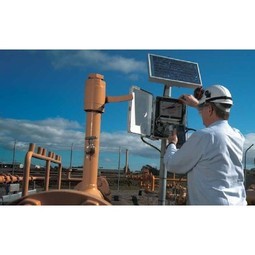Customer Company Size
Large Corporate
Region
- Asia
Country
- India
Product
- ICONICS GENESIS64™
- GraphWorX™64
- TrendWorX™64
- ICONICS WebHMI™
- ReportWorX™
Tech Stack
- OPC-integrated HMI/SCADA
- Windows Server® 2008
- Windows Vista®
- SQL Server
Implementation Scale
- Enterprise-wide Deployment
Impact Metrics
- Productivity Improvements
- Customer Satisfaction
Technology Category
- Application Infrastructure & Middleware - Data Exchange & Integration
Applicable Industries
- Utilities
- Cities & Municipalities
Applicable Functions
- Facility Management
- Logistics & Transportation
Use Cases
- Water Utility Management
- Remote Asset Management
- Real-Time Location System (RTLS)
Services
- System Integration
- Software Design & Engineering Services
About The Customer
The Hyderabad Metropolitan Water Supply & Sewerage Board (HMWSSB) was constituted on 1/11/1989 under the provisions of the Hyderabad Metropolitan Water Supply and Sewerage Act 1989 (Act No . 15 of 1989), with the following functions and responsibilities in the Hyderabad Metropolitan Area: Supply of potable water including planning, design, construction, maintenance, operation and management of water supply system. The board is also involved in other water-related projects including rainwater harvesting and water bottling/canning.
The Challenge
Hyderabad, the capital city of the state of Andhra Pradesh in India, is a rapidly growing urban area with a semi-arid climate and a rainfall of 75 cms. The city faces a premium on water during the hot dry months, with a respite from the heat and relative water scarcity coming during the monsoon season, which typically lasts from late June to early October. The Hyderabad Metropolitan Water Supply & Sewerage Board (HMWSSB) has been tasked with ensuring a reliable source of water and waste treatment for its citizens. The board is also involved in other water-related projects including rainwater harvesting and water bottling/canning. The board sought assistance in automating its water supply/sewer facilities and contacted Nish Automation who, in turn, recommended ICONICS’ industrial automation software solutions, specifically the company’s GENESIS64 suite that integrates with new 64-bit computing machinery and the latest operating systems from Microsoft (including Windows Vista® and Windows Server® 2008).
The Solution
The HMWSSB, working with Nish Automation Pvt Ltd of Surat, selected ICONICS GENESIS64™ 64-bit-enhanced, Webenabled, OPC-integrated HMI/SCADA suite, including its GraphWorX™64 graphics development/runtime environment and TrendWorX™64 data collection/logging/ charting/reporting/analysis components. The agency also installed ICONICS WebHMI™ Web-based real-time automation software as well as ReportWorX™ enterprise reporting, charting and analysis software, which is a component of the BizViz™ business visualization suite. Industrial PCs running GENESIS64, WebHMI (5 nodes), ReportWorX Lite and other ICONICS software connect to 84 Remote Terminal Units (RTUs) (with Schneider Electric PLCs for I/O), which are, in turn, connected by seven Matrix Simado GDT11 fixed cellular terminals (FTCs) and a Moxa Nport 5610 Serial Driver. These RTU/PLC systems are hardwired locally to Siemens flow meters, level transmitters, etc. for the purpose of water auditing via SCADA.
Operational Impact

Case Study missing?
Start adding your own!
Register with your work email and create a new case study profile for your business.
Related Case Studies.

Case Study
Turning A Stadium Into A Smart Building
Honeywell created what it called the “intelligent system” for the National Stadium in Beijing, China, turning the venue for the opening and closing events at the 2008 Summer Olympics into a “smart building.” Designed by highly controversial artist Ai Weiwei, the “Bird’s Nest” remains one of the most impressive feats of stadium architecture in the world. The 250,000 square meter structure housed more than 100,000 athletes and spectators at a time. To accommodate such capacity, China turned to Honeywell’s EBI Integrated Building Management System to create an integrated “intelligent system” for improved building security, safety and energy efficiency.

Case Study
IoT Solutions for Smart City | Internet of Things Case Study
There were several challenges faced: It is challenging to build an appliance that can withstand a wide range of voltage fluctuations from as low at 90v to as high as 320v. Since the device would be installed in remote locations, its resilience was of paramount importance. The device would have to deal with poor network coverage and have the ability to store and re-transmit data if networks were not available, which is often the case in rural India. The device could store up to 30 days of data.

Case Study
Automation of the Oguz-Gabala-Baku water pipeline, Azerbaijan
The Oguz-Gabala-Baku water pipeline project dates back to plans from the 1970’s. Baku’s growth was historically driven by the booming oil industry and required the import of drinking water from outside of the city. Before the construction of the pipeline, some 60 percent of the city’s households received water for only a few hours daily. After completion of the project, 75 percent of the two million Baku residents are now served around the clock with potable water, based on World Health Organization (WHO) standards. The 262-kilometer pipeline requires no pumping station, but uses the altitude differences between the Caucasian mountains and the capital to supply 432,000 m³/d to the Ceyranbatan water reservoir. To the people of Baku, the pipeline is “the most important project not only in 2010, but of the last 20 years.”

Case Study
GPRS Mobile Network for Smart Metering
Around the world, the electricity supply industry is turning to ‘smart’ meters to lower costs, reduce emissions and improve the management of customer supplies. Smart meters collect detailed consumption information and using this feedback consumers can better understand their energy usage which in turn enables them to modify their consumption to save money and help to cut carbon emissions. A smart meter can be defined in many ways, but generally includes an element of two-way communication between the household meter and the utility provider to efficiently collect detailed energy usage data. Some implementations include consumer feedback beyond the energy bill to include online web data, SMS text messages or an information display in consumers’ premises. Providing a cost-effective, reliable communications mechanism is one of the most challenging aspects of a smart meter implementation. In New Zealand, the utilities have embraced smart metering and designed cost effective ways for it to be implemented. The New Zealand government has encouraged such a move to smart metering by ensuring the energy legislation is consistent with the delivery of benefits to the consumer while allowing innovation in this area. On the ground, AMS is a leader in the deployment of smart metering and associated services. Several of New Zealand’s energy retailers were looking for smart metering services for their residential and small business customers which will eventually account for over 500,000 meters when the multi-year national deployment program is concluded. To respond to these requirements, AMS needed to put together a solution that included data communications between each meter and the central data collection point and the solution proposed by Vodafone satisfied that requirement.
.png)
Case Study
Smart Street Light Network (Copenhagen)
Key stakeholders are taking a comprehensive approach to rethinking smart city innovation. City leaders have collaborated through partnerships involving government, research institutions and solution providers. The Copenhagen Solutions Lab is one of the leading organizations at the forefront of this movement. By bringing together manufacturers with municipal buyers, the Copenhagen Solutions Lab has catalyzed the development and deployment of next-generation smart city innovations. Copenhagen is leveraging this unique approach to accelerate the implementation of smart city solutions. One of the primary focus areas is LED street lighting.

Case Study
NB-IoT connected smart meters to improve gas metering in Shenzhen
Shenzhen Gas has a large fleet of existing gas meters, which are installed in a variety of hard to reach locations, such as indoors and underground, meaning that existing communications networks have struggled to maintain connectivity with all meters. The meter success rate is low, data transmissions are so far unstable and power consumption is too high. Against this background, Shenzhen Gas, China Telecom, Huawei, and Goldcard have jointly trialed NB-IoT gas meters to try and solve some of the challenges that the industry faces with today’s smart gas meters.






